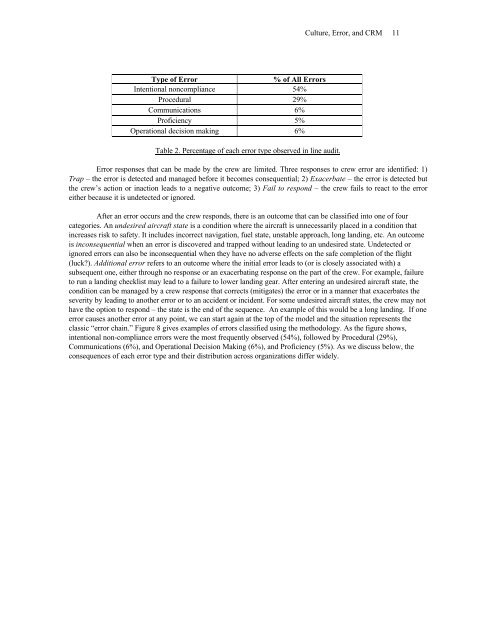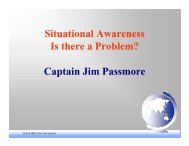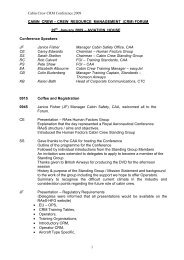Culture, Error, and Crew Resource Management - Human Factors ...
Culture, Error, and Crew Resource Management - Human Factors ...
Culture, Error, and Crew Resource Management - Human Factors ...
Create successful ePaper yourself
Turn your PDF publications into a flip-book with our unique Google optimized e-Paper software.
Type of <strong>Error</strong> % of All <strong>Error</strong>s<br />
Intentional noncompliance 54%<br />
Procedural 29%<br />
Communications 6%<br />
Proficiency 5%<br />
Operational decision making 6%<br />
Table 2. Percentage of each error type observed in line audit.<br />
<strong>Culture</strong>, <strong>Error</strong>, <strong>and</strong> CRM 11<br />
<strong>Error</strong> responses that can be made by the crew are limited. Three responses to crew error are identified: 1)<br />
Trap – the error is detected <strong>and</strong> managed before it becomes consequential; 2) Exacerbate – the error is detected but<br />
the crew’s action or inaction leads to a negative outcome; 3) Fail to respond – the crew fails to react to the error<br />
either because it is undetected or ignored.<br />
After an error occurs <strong>and</strong> the crew responds, there is an outcome that can be classified into one of four<br />
categories. An undesired aircraft state is a condition where the aircraft is unnecessarily placed in a condition that<br />
increases risk to safety. It includes incorrect navigation, fuel state, unstable approach, long l<strong>and</strong>ing, etc. An outcome<br />
is inconsequential when an error is discovered <strong>and</strong> trapped without leading to an undesired state. Undetected or<br />
ignored errors can also be inconsequential when they have no adverse effects on the safe completion of the flight<br />
(luck?). Additional error refers to an outcome where the initial error leads to (or is closely associated with) a<br />
subsequent one, either through no response or an exacerbating response on the part of the crew. For example, failure<br />
to run a l<strong>and</strong>ing checklist may lead to a failure to lower l<strong>and</strong>ing gear. After entering an undesired aircraft state, the<br />
condition can be managed by a crew response that corrects (mitigates) the error or in a manner that exacerbates the<br />
severity by leading to another error or to an accident or incident. For some undesired aircraft states, the crew may not<br />
have the option to respond – the state is the end of the sequence. An example of this would be a long l<strong>and</strong>ing. If one<br />
error causes another error at any point, we can start again at the top of the model <strong>and</strong> the situation represents the<br />
classic “error chain.” Figure 8 gives examples of errors classified using the methodology. As the figure shows,<br />
intentional non-compliance errors were the most frequently observed (54%), followed by Procedural (29%),<br />
Communications (6%), <strong>and</strong> Operational Decision Making (6%), <strong>and</strong> Proficiency (5%). As we discuss below, the<br />
consequences of each error type <strong>and</strong> their distribution across organizations differ widely.




